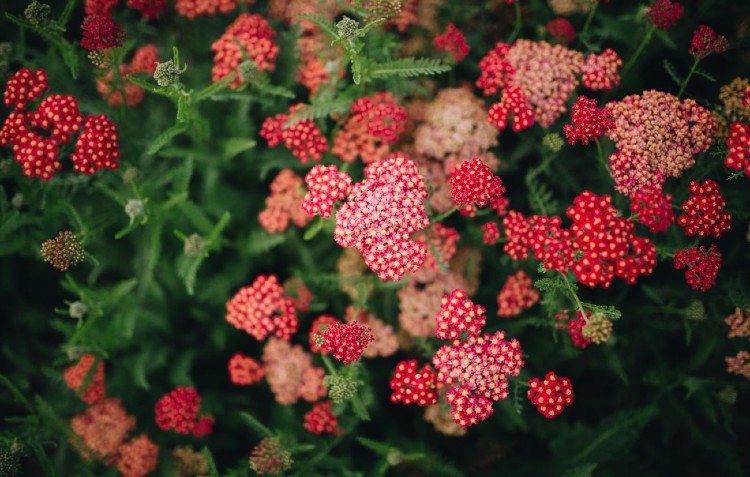Are your flowers drooping? Does your garden fade into the background? Whether you have a balcony or acreage, one flower bed or 10, there’s still time to get water wise and turn it around to create a colourful backyard the neighbours will envy.
Be Water Wise

Water is essential for any garden plant to grow, but how much water your garden needs can vary between soil types, sunlight and genus of flower. If you have sandy soil in your patch then water will be absorbed and used more quickly than if you have clay soil, which holds water really well – sometimes too well! Loam soil is the perfect middle ground, easily absorbing water without drying out too fast. If you’re using organic matter such as compost or mulch, then your flower patch will need a little more water to soak to the depth you want it to, however the extra matter is fantastic at retaining moisture, so your plants may not require watering as often.
Tip: Get away with watering your flowers less frequently by giving them a good soaking once or twice per week.
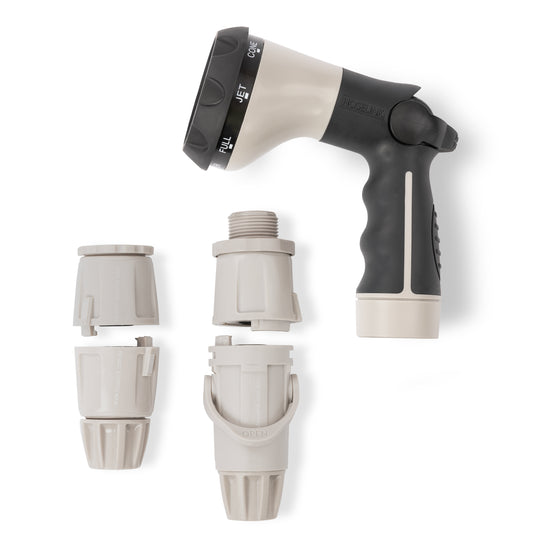
Water Wise Starter Set
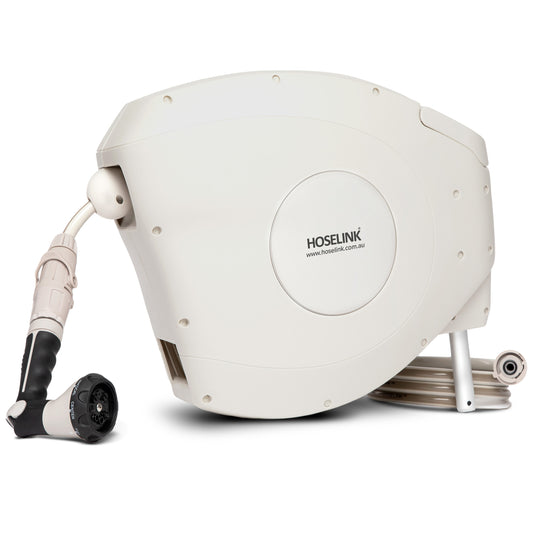
Classic 20m Retractable Hose Reel | Beige
Perfect Timing

Never water at the hottest part of the day. When the sun is blazing, so is your garden, and any water used will evaporate at a rapid rate, depriving your plants of what they need. Watering first thing in the morning or in the late afternoon are the optimum times of day to give your flower patch some TLC. If you live in a humid climate, morning is best, offering your plants plenty of time to dry off throughout the day to avoid fungal disease from dampness. If you have a problem-free patch that isn’t prone to disease, or live in an arid climate, then afternoon watering is fine, though try and avoid saturating leaves.
Tip: Check the weight of your potted plants when dry and compare it to how they feel once they’ve been well watered. Soon you’ll get to know how much water your plants need based on how heavy the pot is.
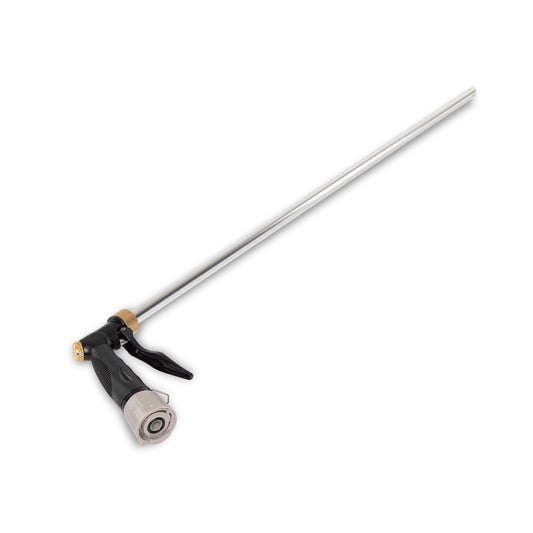
Root Waterer & Soil Breaker
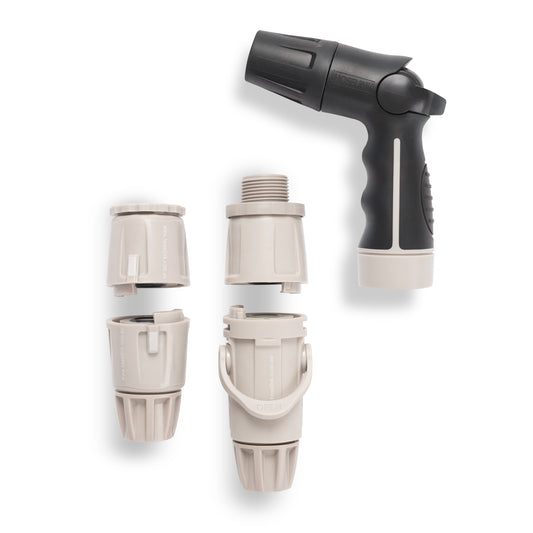
Compact Nozzle Starter Set
Take it Slow

Often watering is much more effective when water is released slowly, directly to the roots of a plant, not its foliage. A happy, well-saturated root zone is the key to a flourishing seedling, house plant, veggie patch or raised flower bed. Hoselink’s Root Waterer & Soil Breaker is designed to help you break up the soil and reach the roots of your plant with ease, allowing you to water direct at the source without wasting a drop.
Tip: A weeper hose is another great way of directing water straight to the roots of a plant with minimal effort and wastage.
Don’t blame it on the weatherman

If the heavens open then turn off that sprinkler! The weather throughout the year determines just how much extra water your garden actually needs, so pay close attention. Depending on the part of Australia you live in, you can take a good guess at which is your wettest season and which is your driest. Watering with a timer or sprinkler system is one quick and easy way to meet your garden’s needs with minimal effort, allowing you to set a day, time and frequency to water your yard that can be adjusted through the seasons.
Tip: Where you position your plants will affect how they grow and how much water they will need. Partially shaded or sheltered spots won’t require as much water as open, sunny spots, but remember if rain begins to fall then those shady and sheltered areas may not feel the benefit, so could still need some extra water.
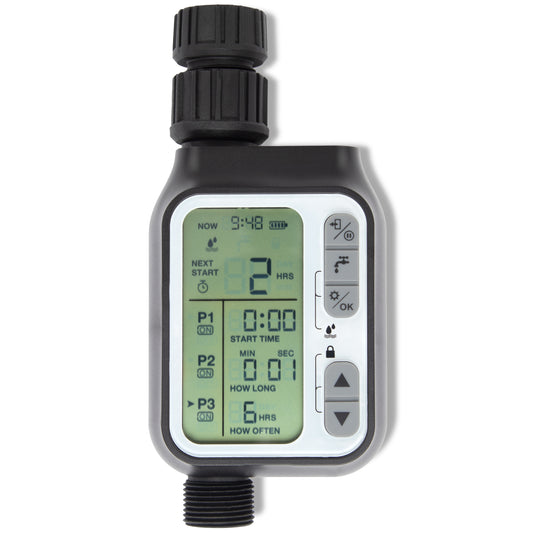
Automatic Tap Timer with Rain Sensor

Automatic Tap Timer with Rain Sensor
Debunk the myths…

Wilting flowers need more water, drought-tolerant plants don’t need watering, there’s no wrong way to water a plant… there are plenty of myths out there when it comes to watering your backyard. To help demystify some of them we’ve separated the facts from the fiction...
It doesn’t matter how I water my plants
Wrong, it does! Applying water directly to the soil is the most efficient way of saturating your plants. Spraying flower heads and leaves can cause damage if a strong spray is used, and wet foliage can lead to fungal problems and disease, so it's best to use a gentler spray, such as the Hoselink soft spray Shower Wand, and aim water directly at the soil wherever possible. This doesn’t mean you shouldn’t ever water from overhead, of course when using a sprinkler it is unavoidable, however altering your watering to first thing in the morning will at least give your plants time to dry out during the day. Watering in this way can also help keep leaves clean, get rid of pests and cool plants down during a heatwave.
Drought-tolerant plants take care of themselves
Unfortunately this isn't strictly true. When sowing any drought-tolerant plant it is necessary to water and nurture them to help them establish and get through the first season. Once established there are many species that will survive on rain water alone, however some will need supplemental water in particularly dry spells.
When it rains I don’t need to water the garden
This actually depends on how much rain has fallen and if it has reached all parts of your garden. If you’ve only had a light shower then the water may not have penetrated through the soil to the roots of your plants, whilst a more moderate rain shower may not have been effective if it arrived after a very dry period. It’s also important to review any sheltered spots of the garden. The best advice is to keep a close eye on the weather to help you judge what your garden needs and when.
All plants require the same amount of water
False. There are so many different plant varieties and species out there that they each have their own watering and feeding needs. Some plants require daily watering in summer and much less in winter, some rely on a regular water supply throughout the year, or require a good soaking only once or twice a week, whilst others, like drought-tolerant agave and echium plants, won’t need hardly a drop. It’s best to research what your plants will need before sowing them in your garden.
A wilted plant just needs a drop of water to perk up
Whilst a wilted plant is usually a sign that it’s not getting enough moisture, it may not mean the soil needs a good soaking. Poor quality soil without enough drainage could be what’s damaging the plant, particularly if it’s being over-watered. Roots require water and air, and over-watering can be as damaging as under-watering as it prevents the roots from airing and/or delivering a sufficient supply of water to the plant’s stems and leaves. Always check soil moisture first before reaching for the hose.

